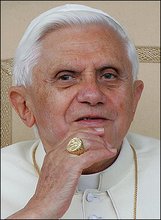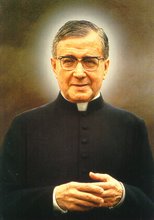
The high point of my trip home, which I intended to have something of the feel of a pilgrimage about it, happened yesterday. We visited the beautiful and ancient village of East Hendred, specifically to visit Hendred House, the home of the Eyston family since 1443. The house, which is not open to the public, is mainly 15th Century, but the Chapel - St. Amand's, was built in 1256. It is one of only three chapels in England built before the so-called Reformation which has never been used for Protestant worship. Mass was celebrated in secret throughout Penal times, and, although the Chapel was desecrated by Cromwell's soldiers, the ancient stained glass was not destroyed. Mass is still said in the Chapel (ad orientem - of course!) weekly. We were guests of the present Lord of the Manor, Edward Eyston, who kindly showed us around. We were able to visit because two of the Eyston girls are nuns in the Sisters of the Assumption - and my Aunt is an Assumption nun - so she came on the trip. (Really sharp readers will remember that it was for Assumption girls that Ronnie Knox wrote books like 'The Mass in Slow Motion' during the war.) The Eystons can trace their ancestry directly back to the family of St. Thomas More and it is because of the incredible relics the family own that I really wanted to come on this pilgrimage. Yesterday, I held in my hands the drinking cup of St. Thomas More, the staff of St. John Fisher and kissed a locket containing a good amount of the hair of Bishop Richard Challoner. In addition we saw an original document signed by St. Thomas More, a book given by Cardinal Newman and signed, to Mrs. Eyston - and several wonderful portraits, including one of St. Thomas More in the Tower. The family could not have been more charming and we were most grateful. The local Anglican Church, a minute or two away, is well worth a visit, with parts dating from the 13th Century. The Chancel screen in the Eyston Chapel (yes - the whole village belongs to the family!) is 15th Century. The treasure is a 13th Century Lectern in wood, with a Crusader's foot treading on a three-headed dragon. There is also a charming little Catholic Church, again on Eyston property, built in the 19th Century, but very traditional in style, with Chancel screen etc. Sadly, no resident priest - if things don't work out in Vermont, I may apply for the living! We then repaired to the Eyston Arms, the village pub, for a good old-fashioned pub lunch. Whenever I think of the English Martyrs, especially St. John Fisher and St. Thomas More, I am reminded of the incredible heritage that the Catholic Church in England possesses - and then I read of English Bishops objecting to the Holy Father's Motu Proprio, changing Holy Days of Obligation and courting the 'establishment.' - I suppose there was only ONE John Fisher!










5 comments:
Wow. thanks for the photo and the story. St. Thomas More is my all time favorite male saint. I envy you for getting to see and touch those relics. I'd love it if you have any photos of those too if you'd post them.
What a fantastic opportunity! However, please stay here. Vermont needs priests of your calibre.
It's amazing the screen survived the Reformation intact. From what Duffy wrote in Stripping the Altars, I would gather that few screens did.
Back in 1997, my friend and I were charged with the task of visiting East Hendred to collect the various relics of Ss Thomas More and John Fisher for display in the cathedral. We also had to call in at the nearby Milton Manor to collect Richard Challoner's vestments. In both places, we were treated to tours of the chapels.
Driving back to Portsmouth, our small Fiat was brimming with holiness!
Post a Comment